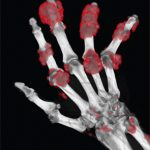 A recent study presented at the National Kidney Foundation’s 2021 Virtual Spring Clinical Meetings, April 6–10, found pegloticase to be safe and effective in patients with gout who are also on dialysis. Pegloticase is a pegylated recombinant form of uricase and was approved by the U.S. Food & Drug Administration (FDA) in September 2010 to treat adults with chronic gout refractory to conventional treatment.1 The treatment is a urate-oxidase enzyme that converts uric acid to allantoin, an inactive and water-soluble uric acid metabolite that is easily excreted from the body.
A recent study presented at the National Kidney Foundation’s 2021 Virtual Spring Clinical Meetings, April 6–10, found pegloticase to be safe and effective in patients with gout who are also on dialysis. Pegloticase is a pegylated recombinant form of uricase and was approved by the U.S. Food & Drug Administration (FDA) in September 2010 to treat adults with chronic gout refractory to conventional treatment.1 The treatment is a urate-oxidase enzyme that converts uric acid to allantoin, an inactive and water-soluble uric acid metabolite that is easily excreted from the body.
In the study, Bleyer et al. evaluated pegloticase in patients with uncontrolled gout who were dialysis dependent, a group not included in pre-marketing clinical trials of the agent.2 Using data from the U.S. Renal Data System (USRDS), researchers studied real-world dialysis patients with end-stage renal disease (ESRD) treated with pegloticase from 2012 to 2017. Patient characteristics and treatment parameters were evaluated.
In the five years of analyzed data, researchers identified 1,824 unique pegloticase claims, with 136 patients prescribed the treatment. Of these patients, 77 patients received pegloticase after ESRD onset, and 59 patients started pegloticase in a two-year period prior to developing ESRD. Of the 77 patients who used pegloticase post-ESRD, 42 patients had dialysis claims between 2012 and 2017 and were undergoing routine outpatient dialysis before starting pegloticase treatment. These 42 patients were evaluated in this analysis.
The Results
Patients were mostly male (76%), white (55%) and had a mean age of 53.5 ± 14.5 years. The majority of patients were between the ages of 45 and 64 (55%). The mean dialysis duration was 31.9 ± 42.9 months, with most patients receiving hemodialysis (76%), continuous cycling peritoneal dialysis (19%) or continuous ambulatory peritoneal dialysis (5%). The mean pegloticase dose was 9.7 mg, and the median interval between pegloticase doses was 14 days (mean: 19.5 days). Nine patients (21%) received at least 12 infusions.
The most common causes of ESRD in these patients were: diabetes (38%), hypertension (26%) and glomerulonephritis (17%). Their most common comorbidities upon dialysis initiation were diabetes (45%), hypertension (81.0%), congestive heart failure (24%), cerebrovascular disease (5%) and cancer (5%). Most patients had more than one comorbidity.
Ninety percent of patients were taking erythropoiesis-stimulating agents prior to starting pegloticase, while 88% of patients started taking erythropoiesis-stimulating agents after commencing pegloticase treatment. Patient hemoglobin levels were similar before and after pegloticase treatment.
The post-ESRD, office-based pegloticase prescribers were mostly rheumatologists (38%). Other office-based prescribers included hematologists, oncologists, physician assistants, pediatricians, internal medicine physicians and family practice physicians. Prescribers at outpatient dialysis facilities accounted for 58% of the post-ESRD pegloticase claims.
In the analysis of these hemodialysis patients, the investigators concluded that pegloticase treatment for refractory gout was safe and effective. Erythropoiesis-stimulating agent (ESA) use was similar before and after pegloticase treatment, but the investigators noticed a significantly lower monthly dose requirement after pegloticase treatment. The monthly ESA dose (n=38) prior to pegloticase was 55,314 units, after pegloticase the monthly ESA dose (n=37) was 37,290 units. This difference was statistically significant and warrants further investigation.
Michele B. Kaufman, PharmD, BCGP, is a freelance medical writer based in New York City and a pharmacist at New York Presbyterian Lower Manhattan Hospital.
References
- U.S. Food & Drug Administration. Center for drug evaluation and research summary review: Application 125293. 2010 Sep 14.
- Bleyer AJ, Zhang Y, Kshirsagar, et al. Pegloticase therapy in gout patients undergoing dialysis: a USRDS database study [abstract 183]. 2021 Apr.


